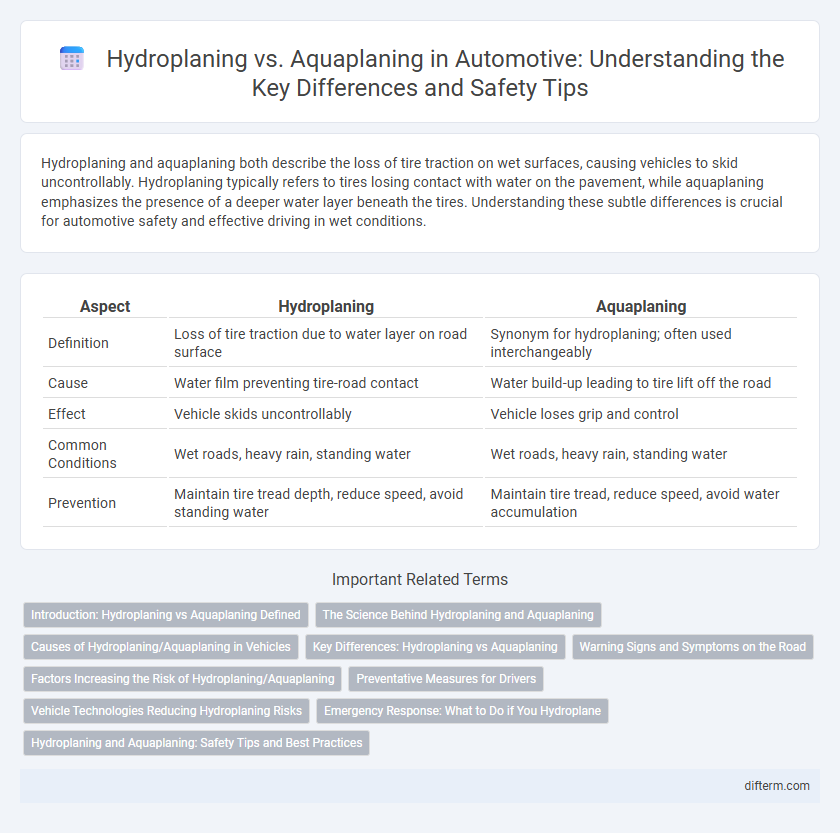Hydroplaning and aquaplaning both describe the loss of tire traction on wet surfaces, causing vehicles to skid uncontrollably. Hydroplaning typically refers to tires losing contact with water on the pavement, while aquaplaning emphasizes the presence of a deeper water layer beneath the tires. Understanding these subtle differences is crucial for automotive safety and effective driving in wet conditions.
Table of Comparison
| Aspect | Hydroplaning | Aquaplaning |
|---|---|---|
| Definition | Loss of tire traction due to water layer on road surface | Synonym for hydroplaning; often used interchangeably |
| Cause | Water film preventing tire-road contact | Water build-up leading to tire lift off the road |
| Effect | Vehicle skids uncontrollably | Vehicle loses grip and control |
| Common Conditions | Wet roads, heavy rain, standing water | Wet roads, heavy rain, standing water |
| Prevention | Maintain tire tread depth, reduce speed, avoid standing water | Maintain tire tread, reduce speed, avoid water accumulation |
Introduction: Hydroplaning vs Aquaplaning Defined
Hydroplaning and aquaplaning both refer to a vehicle losing traction on wet surfaces due to a layer of water between the tires and the road. Hydroplaning often describes the general loss of contact on wet roads, while aquaplaning specifically highlights the tire's inability to channel water away, causing the vehicle to glide uncontrollably. Understanding the nuances between these terms is crucial for improving tire design and enhancing automotive safety features.
The Science Behind Hydroplaning and Aquaplaning
Hydroplaning and aquaplaning occur when a vehicle's tires lose traction on wet surfaces due to a layer of water preventing direct contact with the road. This loss of friction happens as water pressure builds up in front of the tires faster than the water can be displaced, leading to a loss of steering and braking control. Factors like tire tread depth, vehicle speed, and water depth significantly influence the onset and severity of hydroplaning and aquaplaning.
Causes of Hydroplaning/Aquaplaning in Vehicles
Hydroplaning and aquaplaning occur when tires lose traction on wet surfaces due to a thin layer of water preventing direct contact with the road. Causes include high vehicle speed, insufficient tire tread depth, and heavy rainfall that creates standing water on asphalt. Uneven road surfaces and underinflated tires further increase the risk of hydroplaning by reducing the tire's ability to effectively disperse water.
Key Differences: Hydroplaning vs Aquaplaning
Hydroplaning and aquaplaning both refer to the loss of tire traction on wet surfaces, but hydroplaning generally occurs at higher speeds when a layer of water prevents tires from contacting the road. Aquaplaning can describe the same phenomenon but is sometimes used more broadly to include slower-speed loss of control due to water accumulation. Vehicle speed, tire tread depth, and water depth are critical factors influencing the risk and severity of both hydroplaning and aquaplaning events.
Warning Signs and Symptoms on the Road
Hydroplaning and aquaplaning both describe the loss of tire traction on wet surfaces, but hydroplaning refers specifically to tires riding on a thin water film, while aquaplaning involves complete tire lift off the road due to deeper water. Warning signs include sudden loss of steering response, increased difficulty braking, and the vehicle feeling like it is sliding or floating. Drivers should recognize decreased skid resistance and unusual tire noise as critical symptoms indicating imminent hydroplaning or aquaplaning risk on wet roads.
Factors Increasing the Risk of Hydroplaning/Aquaplaning
Factors increasing the risk of hydroplaning and aquaplaning include high vehicle speeds, insufficient tire tread depth, and heavy rainfall leading to water accumulation on the road surface. Poor road drainage and uneven pavement further exacerbate water buildup, intensifying the chances of losing traction. Tire inflation pressure and vehicle weight distribution also significantly impact the likelihood of hydroplaning or aquaplaning during wet driving conditions.
Preventative Measures for Drivers
Hydroplaning and aquaplaning occur when a vehicle's tires lose contact with the road due to water buildup, increasing the risk of accidents. Drivers can prevent these phenomena by maintaining proper tire tread depth above 4/32 inch, reducing speed during wet conditions below posted limits, and avoiding sudden steering or braking maneuvers. Regular tire inflation checks and using tires designed for wet traction, such as all-season or performance rain tires, further enhance resistance against hydroplaning.
Vehicle Technologies Reducing Hydroplaning Risks
Advanced vehicle technologies such as electronic stability control (ESC), anti-lock braking systems (ABS), and tire pressure monitoring systems (TPMS) significantly reduce hydroplaning and aquaplaning risks by enhancing traction and control on wet surfaces. Adaptive cruise control and all-wheel-drive (AWD) systems improve vehicle stability by optimizing power distribution and maintaining consistent tire grip during heavy rain or standing water conditions. Tire tread design innovations, including deep grooves and water evacuation channels, complement these technologies by minimizing water buildup under tires, further reducing the likelihood of hydroplaning events.
Emergency Response: What to Do if You Hydroplane
Hydroplaning, often synonymous with aquaplaning, occurs when a vehicle's tires lose contact with the road surface due to water buildup, leading to a loss of traction and control. In emergency response, it is crucial to avoid sudden braking or sharp turns, instead gently easing off the accelerator and steering straight until traction returns. Maintaining proper tire tread depth and reducing speed during wet conditions significantly minimizes the risk of hydroplaning.
Hydroplaning and Aquaplaning: Safety Tips and Best Practices
Hydroplaning and aquaplaning occur when a vehicle's tires lose contact with the road surface due to water buildup, increasing the risk of accidents. Maintaining proper tire tread depth, reducing speed in wet conditions, and avoiding sudden steering maneuvers are critical safety practices to prevent these hazards. Equipping vehicles with quality tires designed for wet traction and ensuring regular vehicle maintenance further enhances control and safety on slippery roads.
hydroplaning vs aquaplaning Infographic

 difterm.com
difterm.com